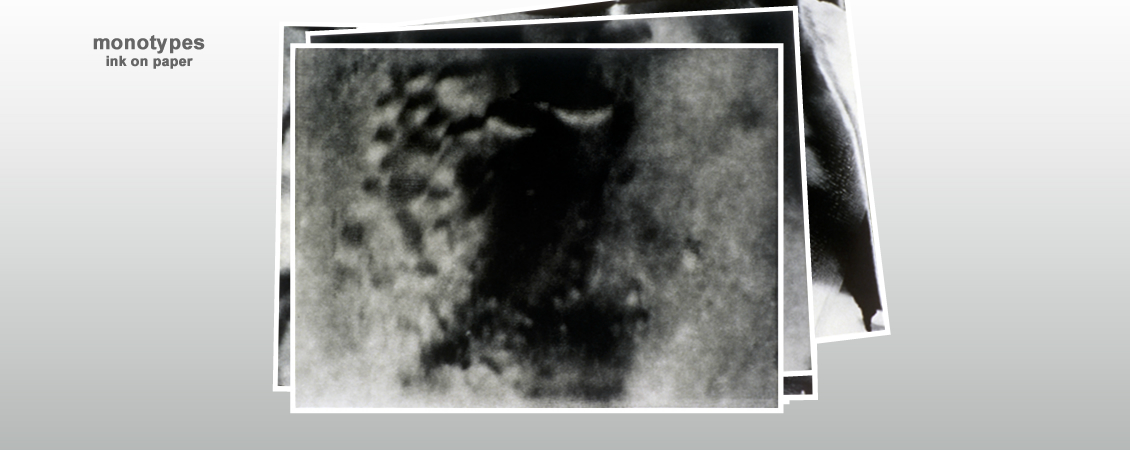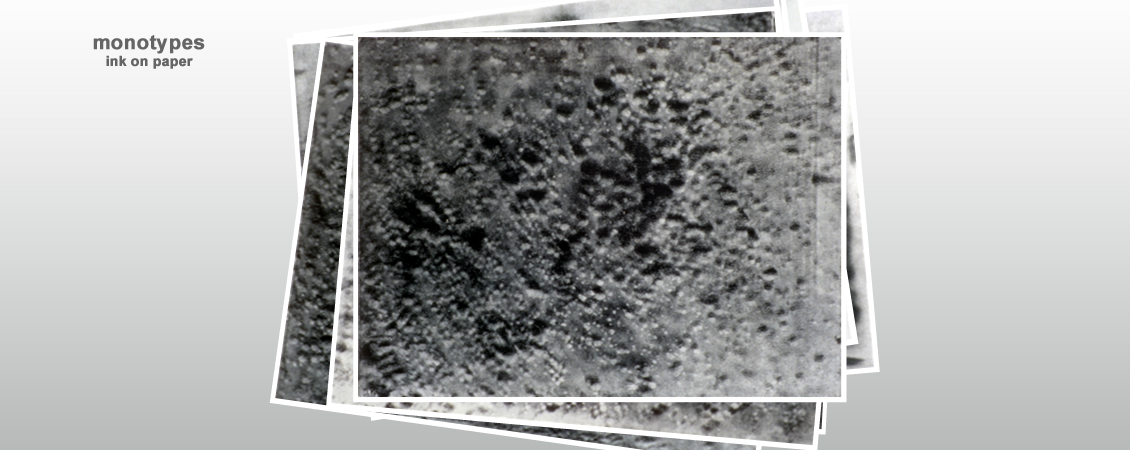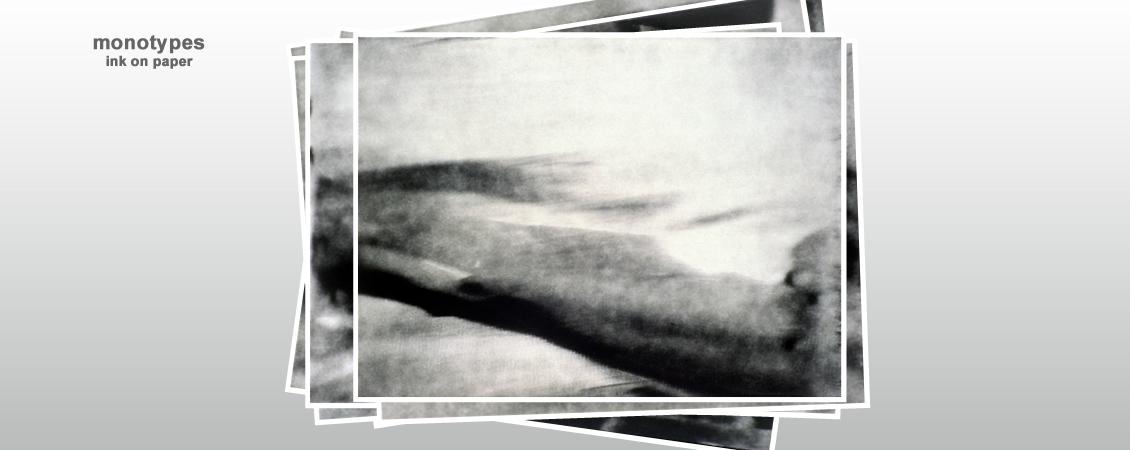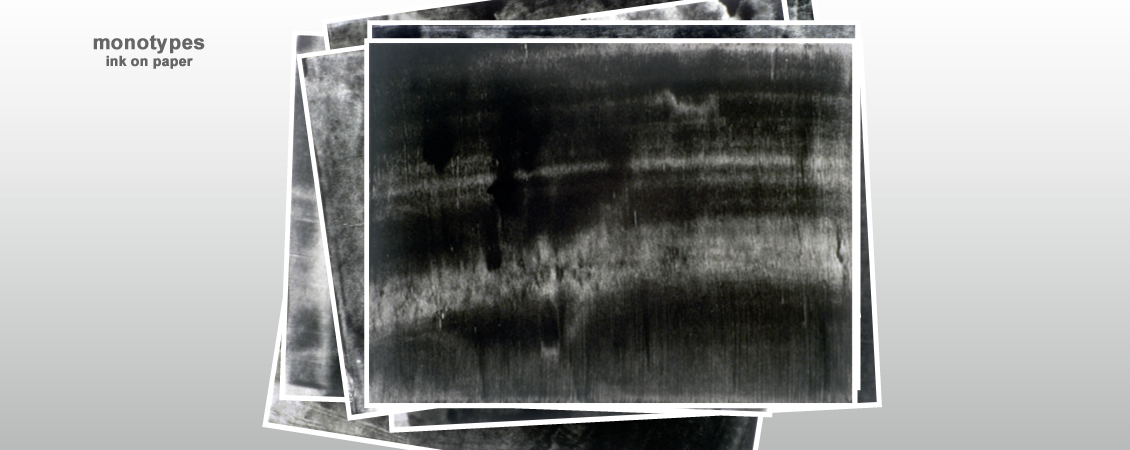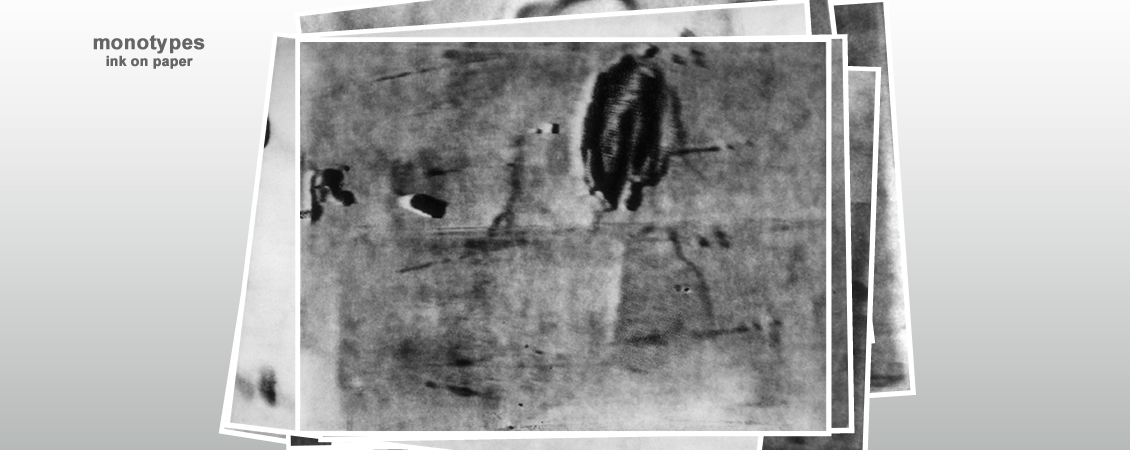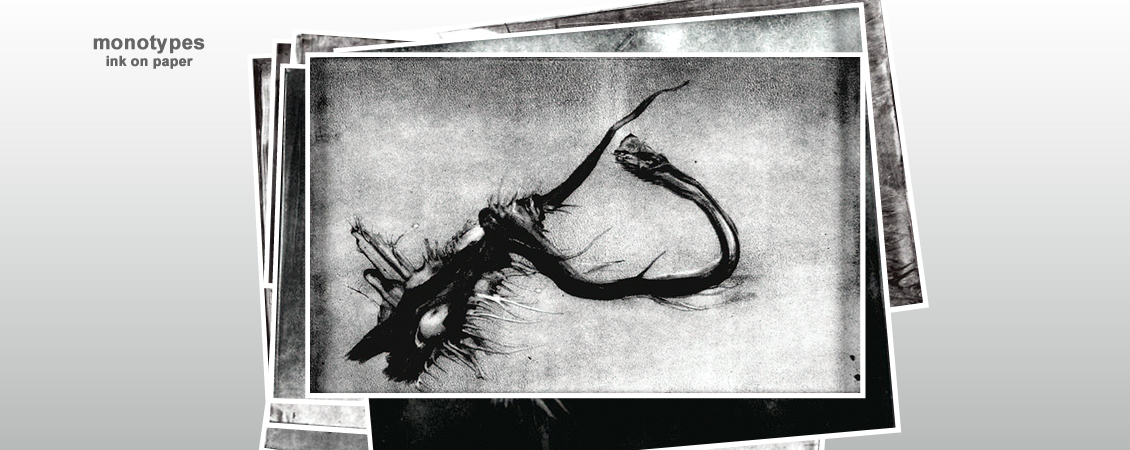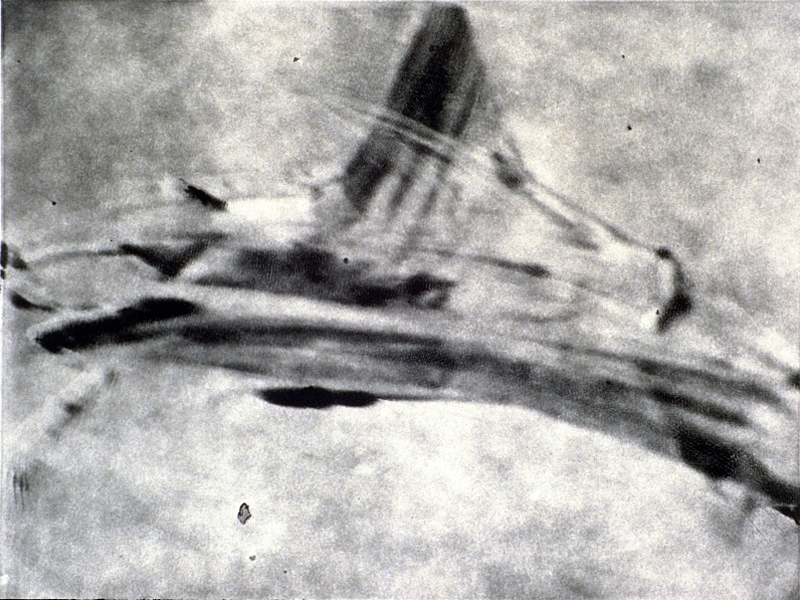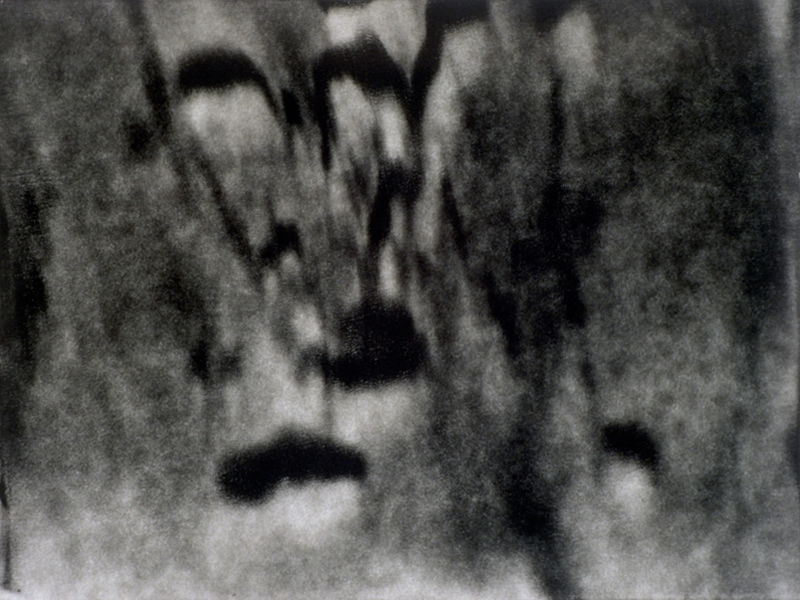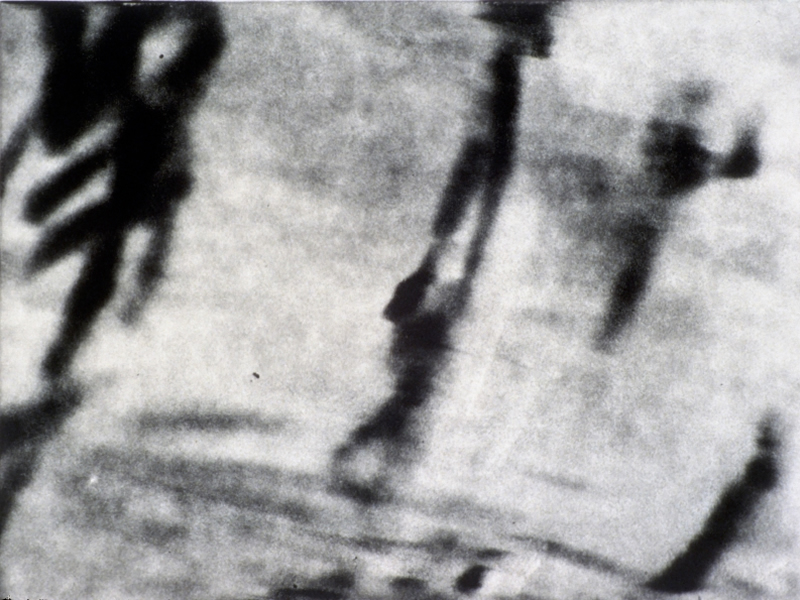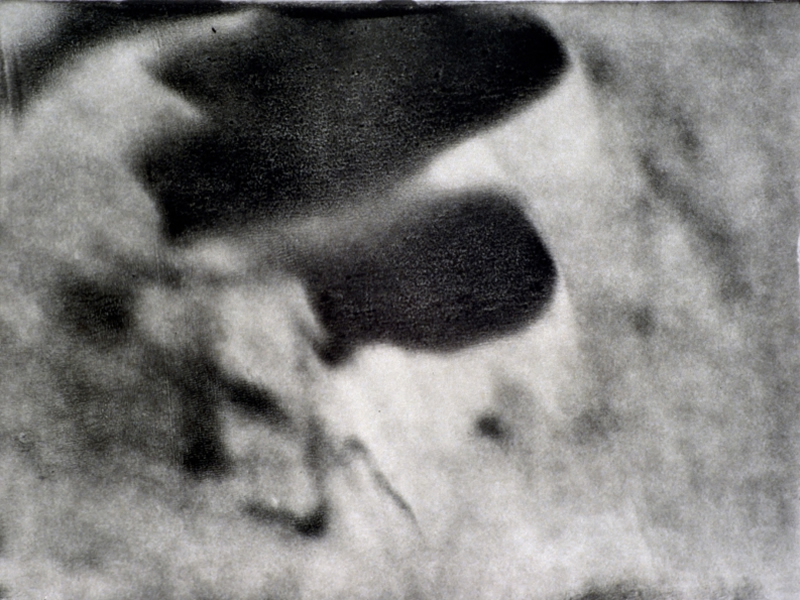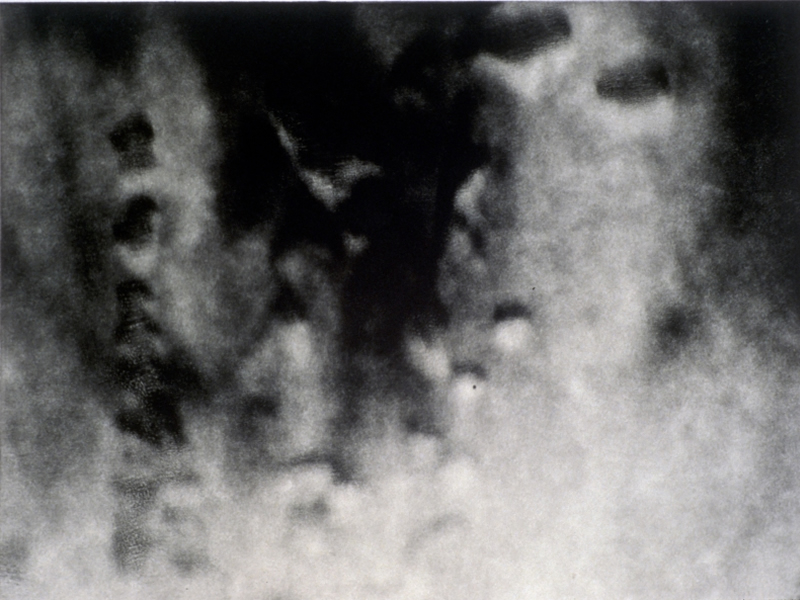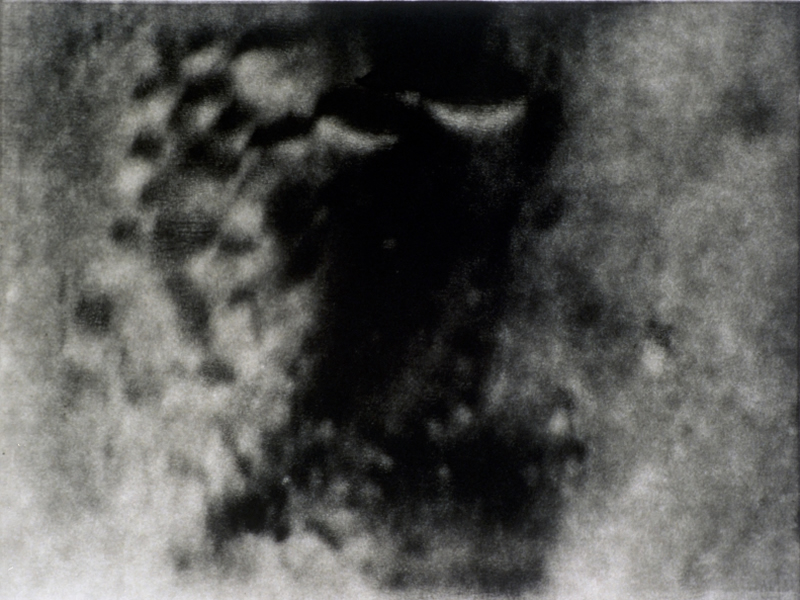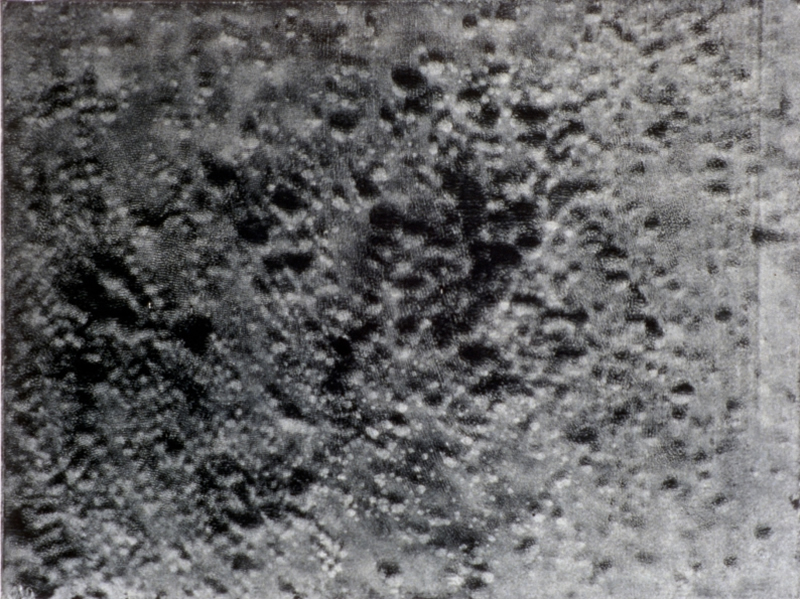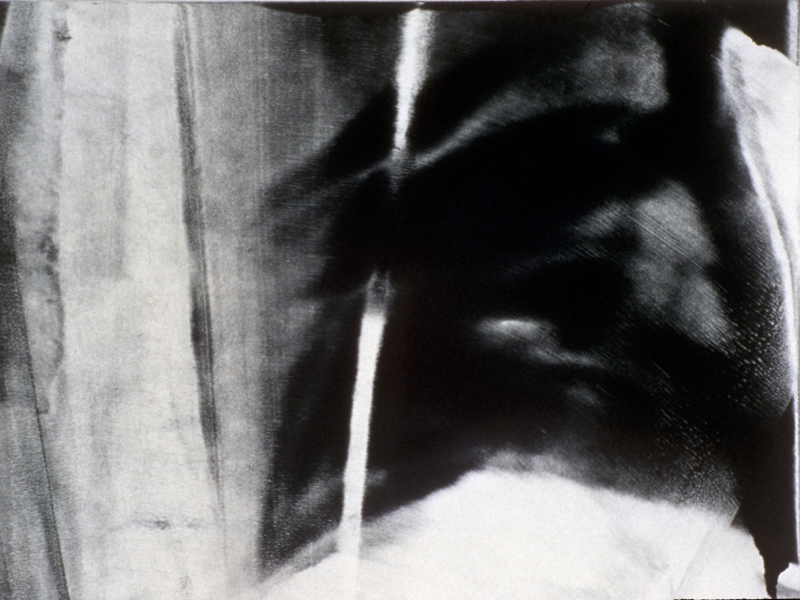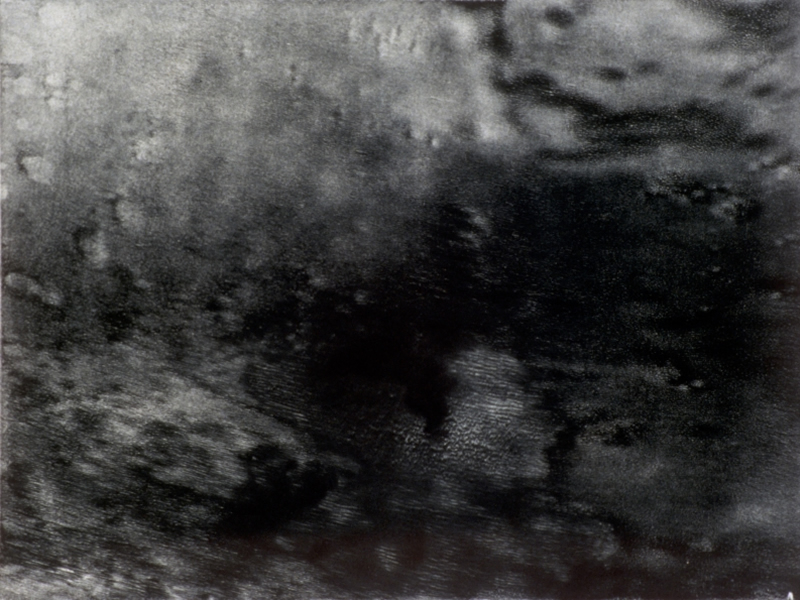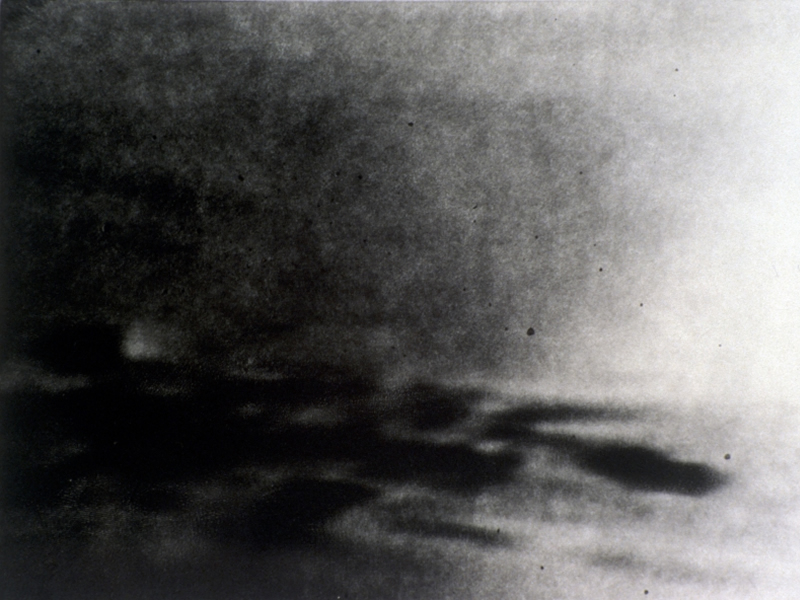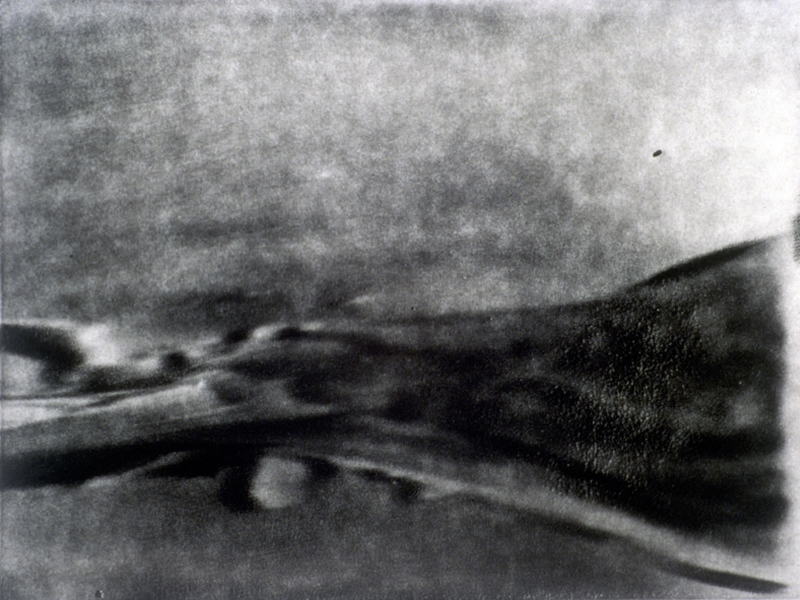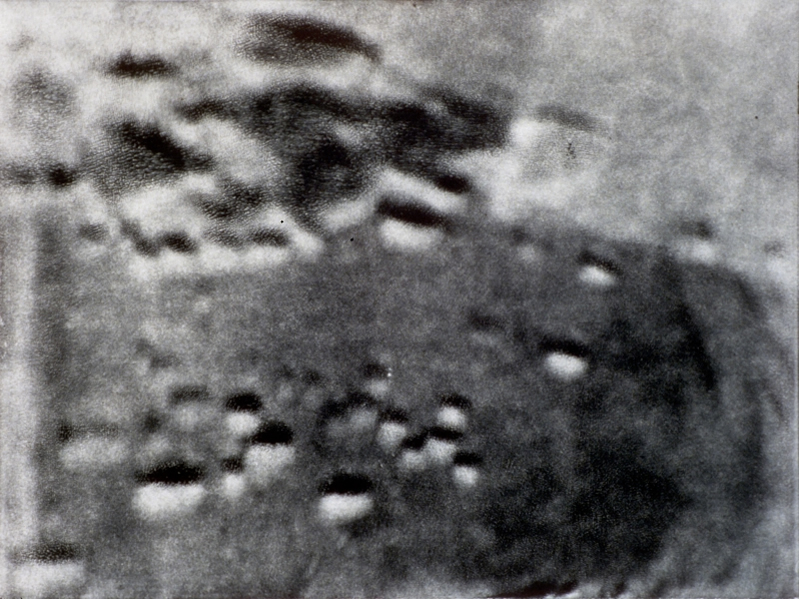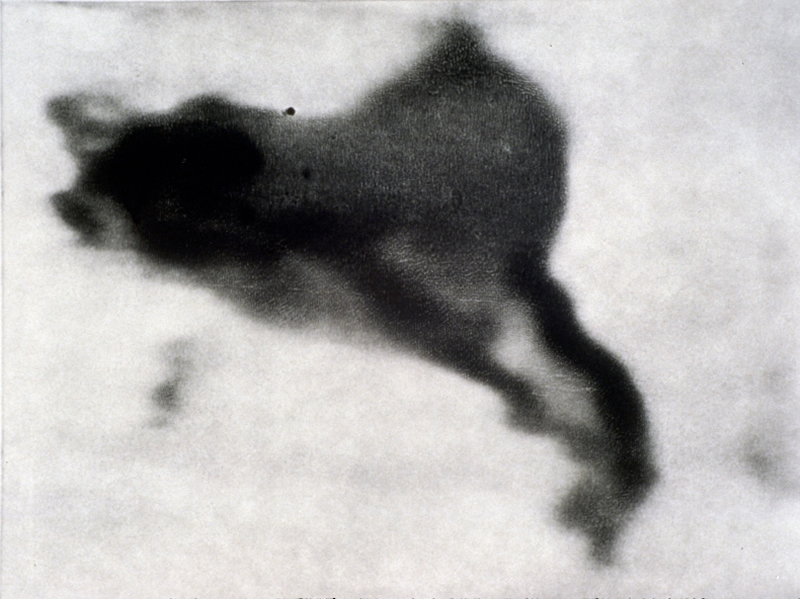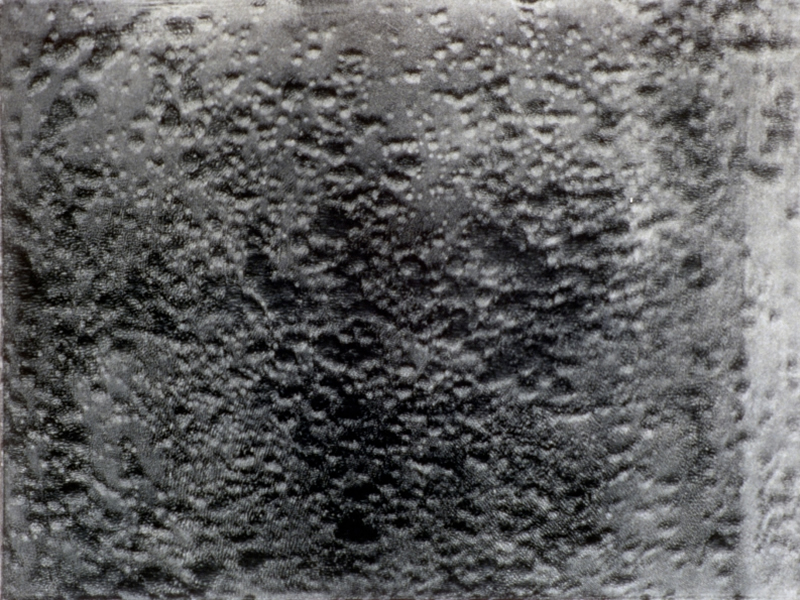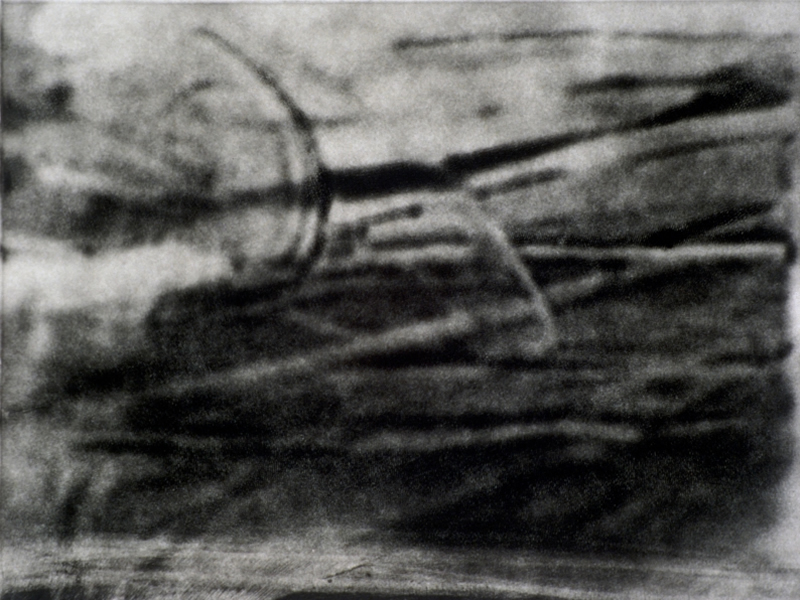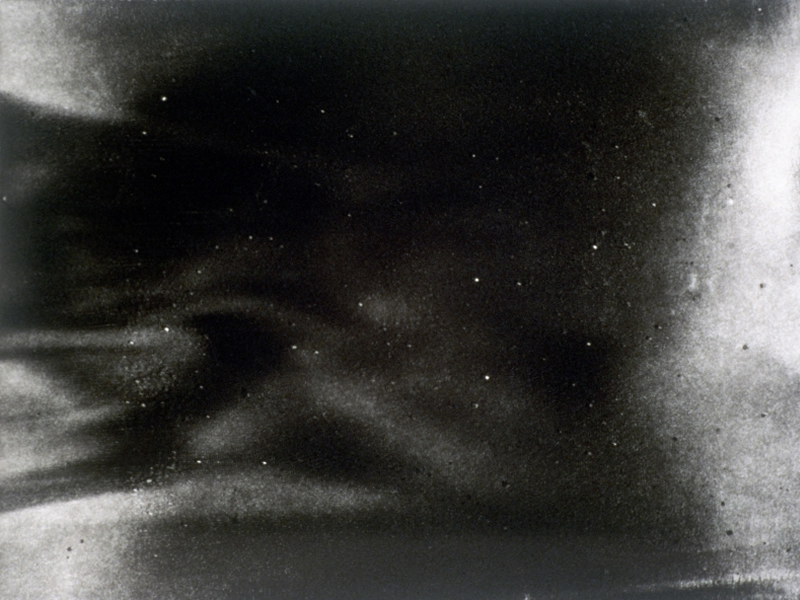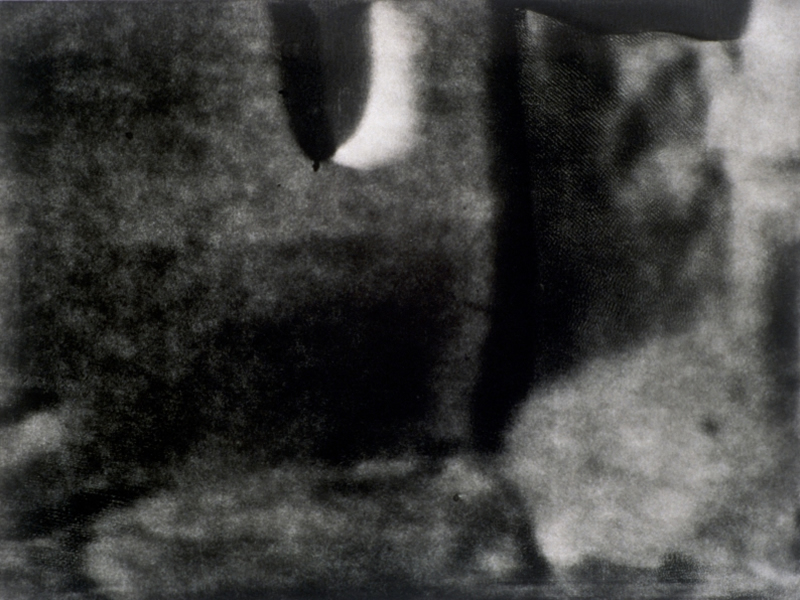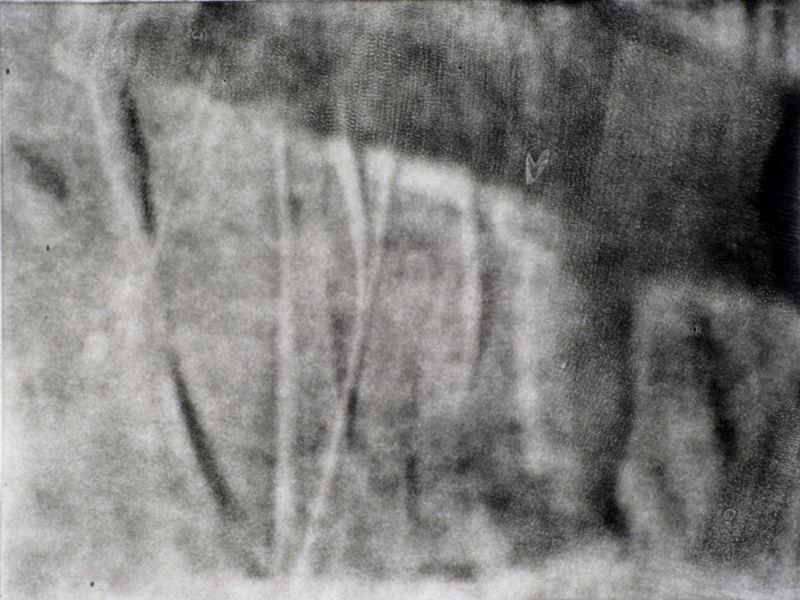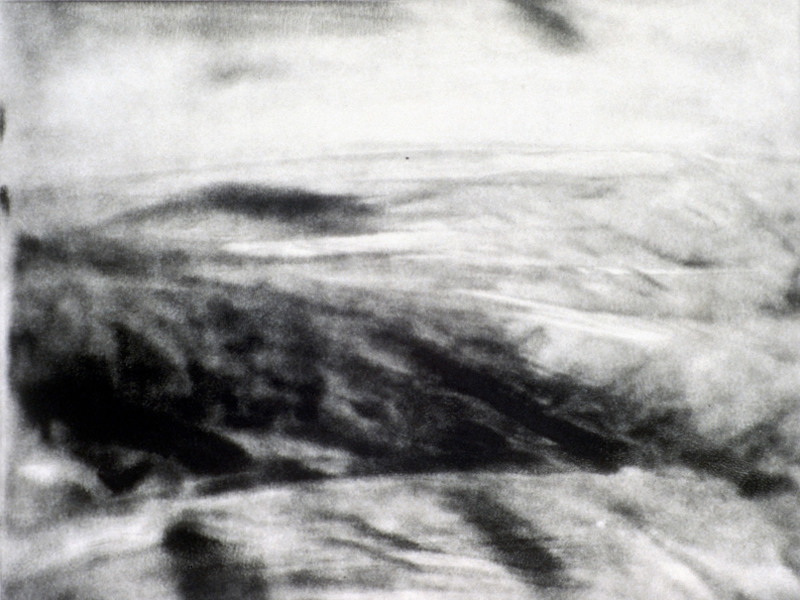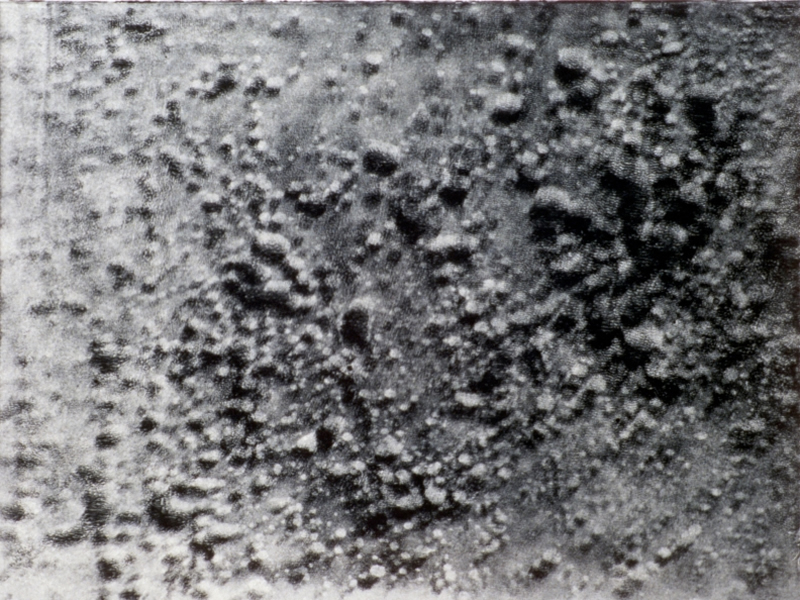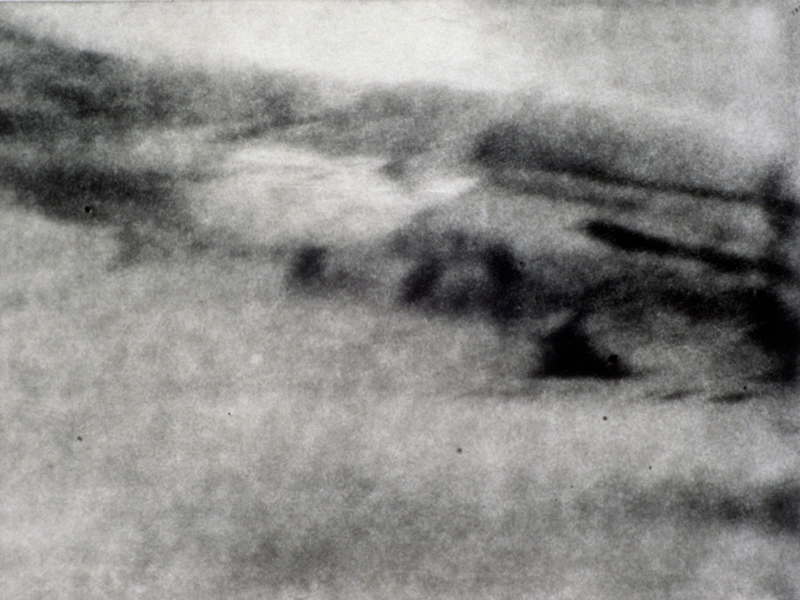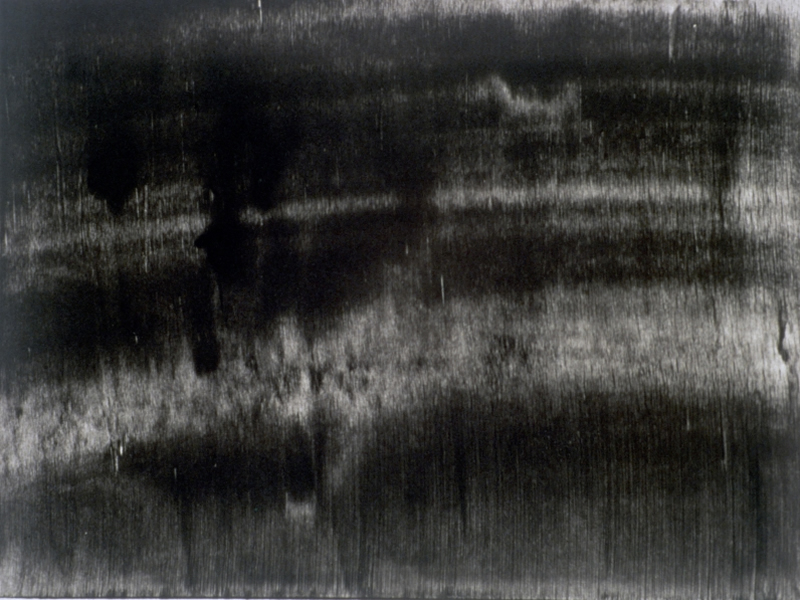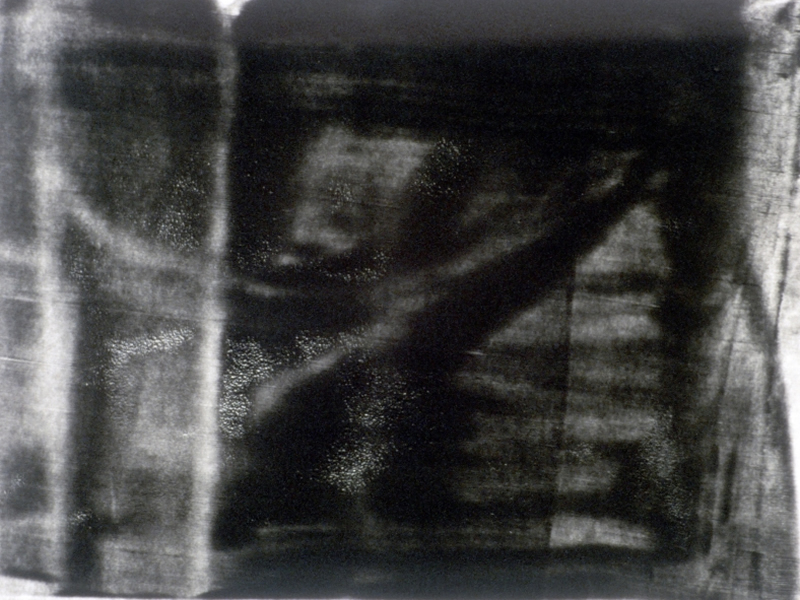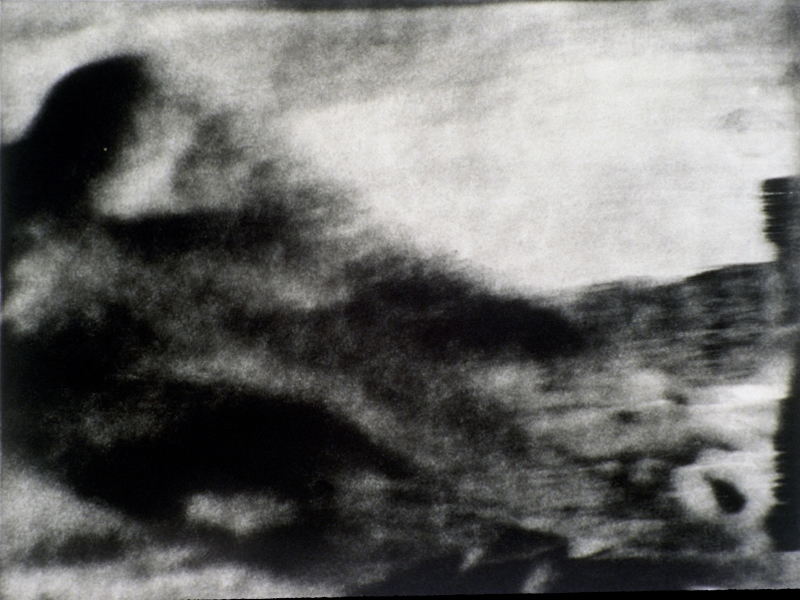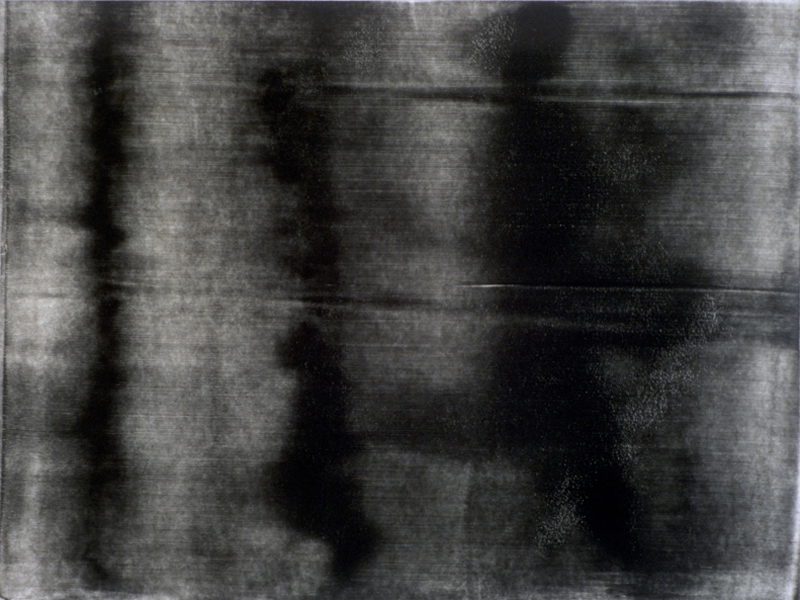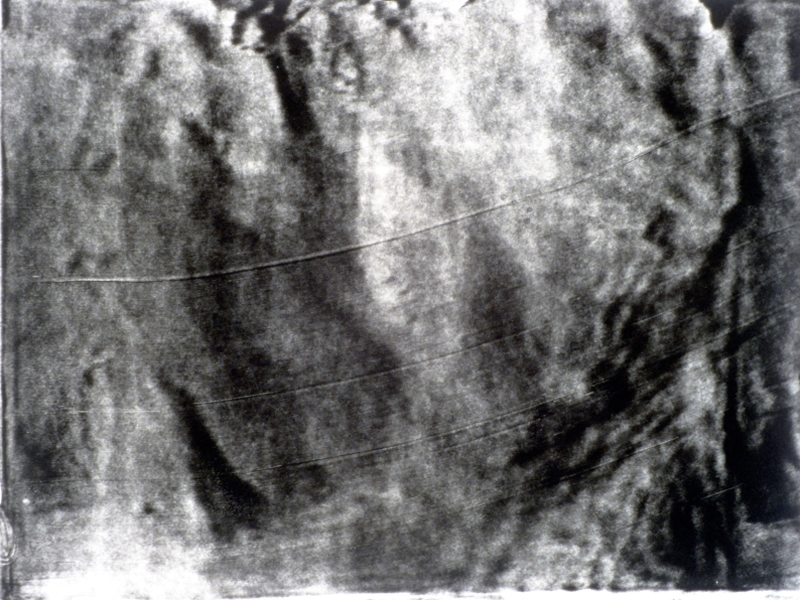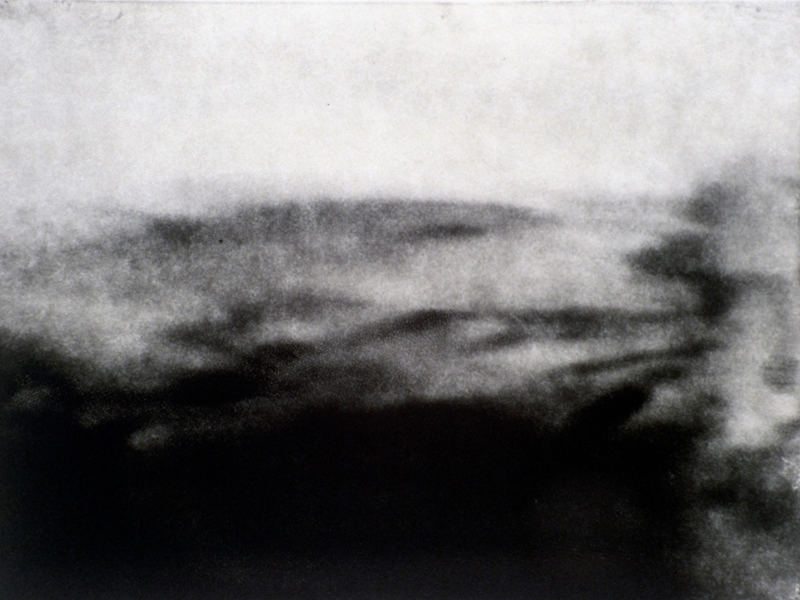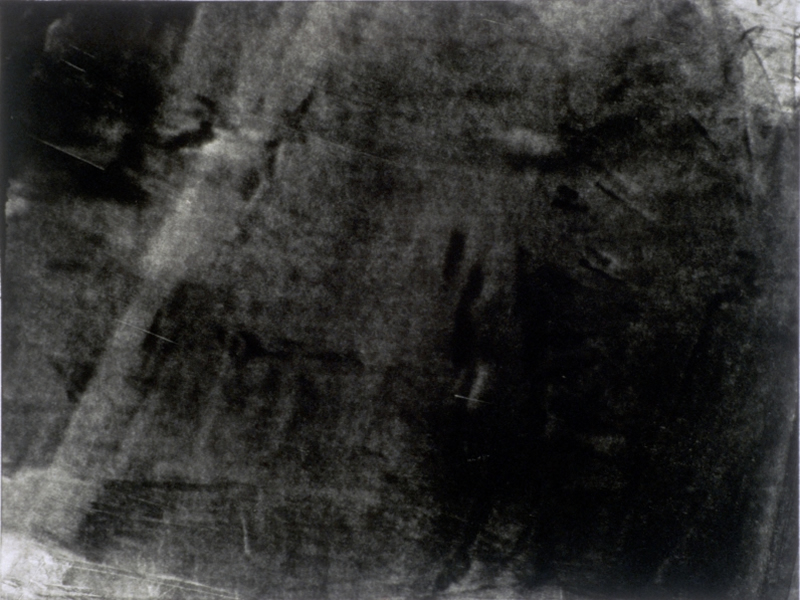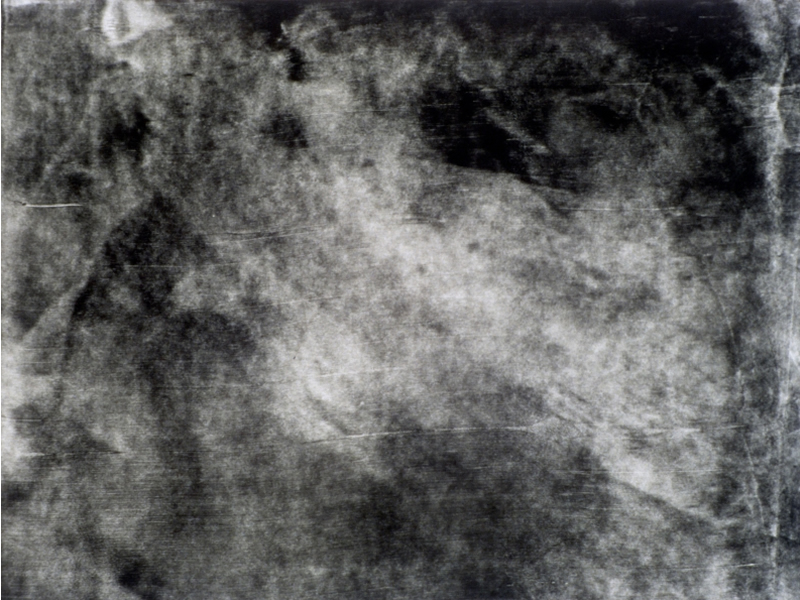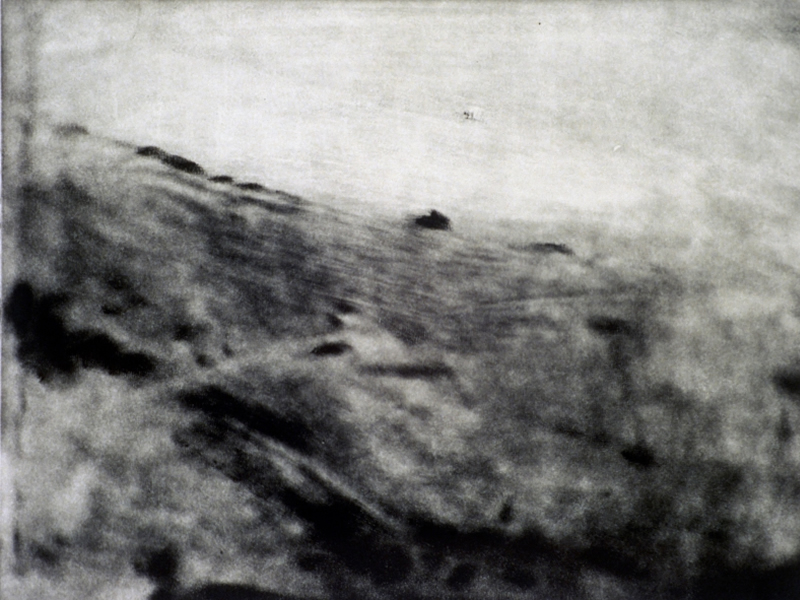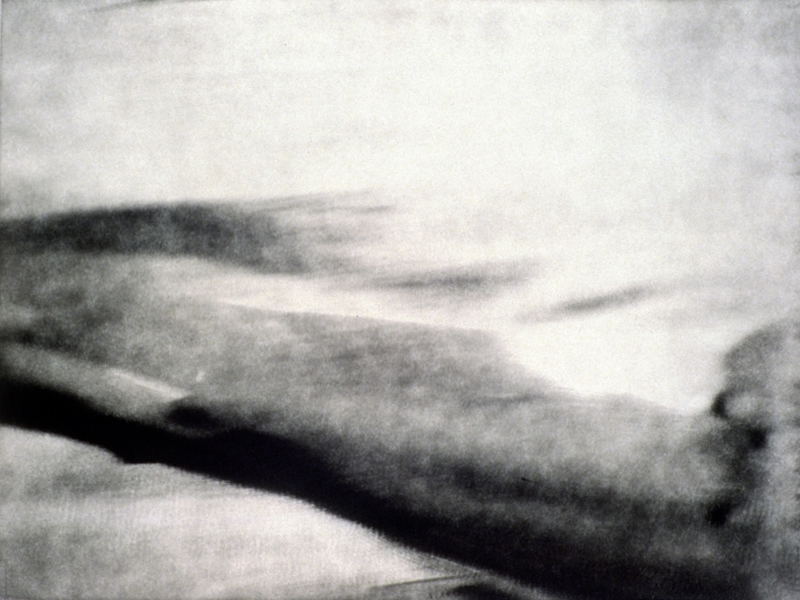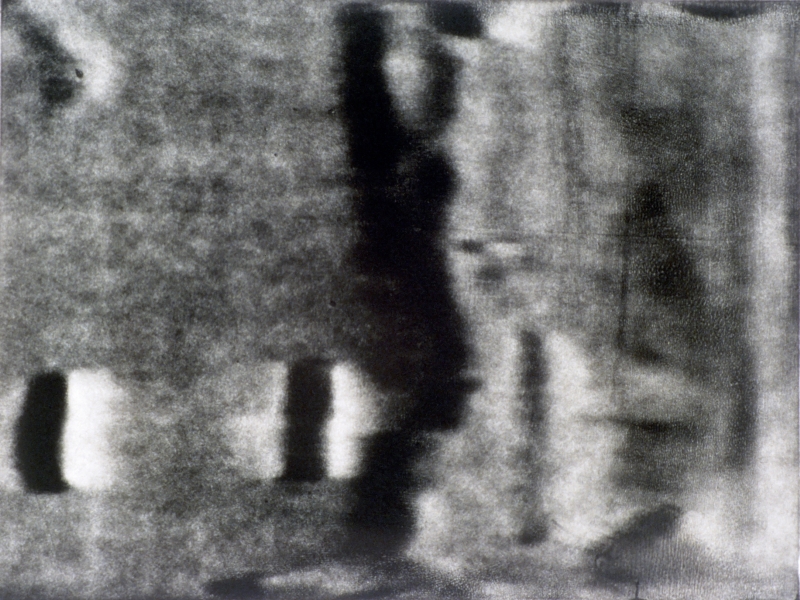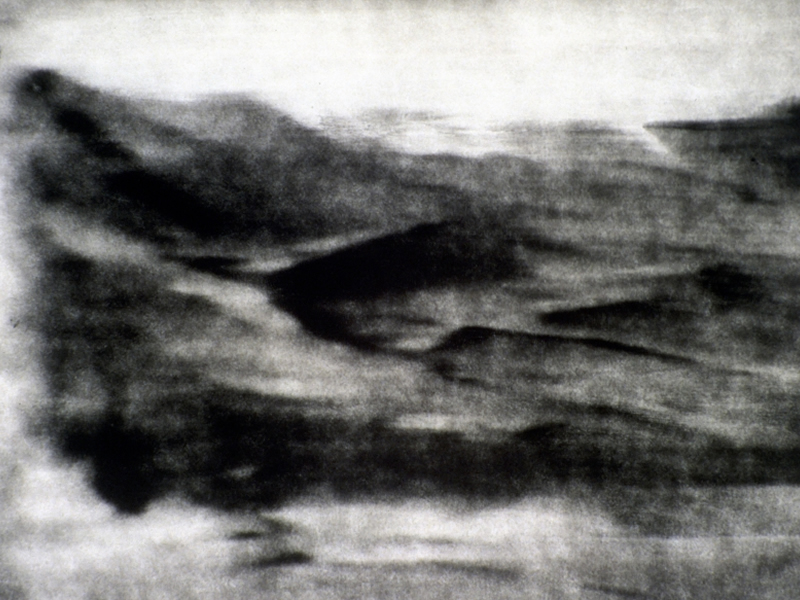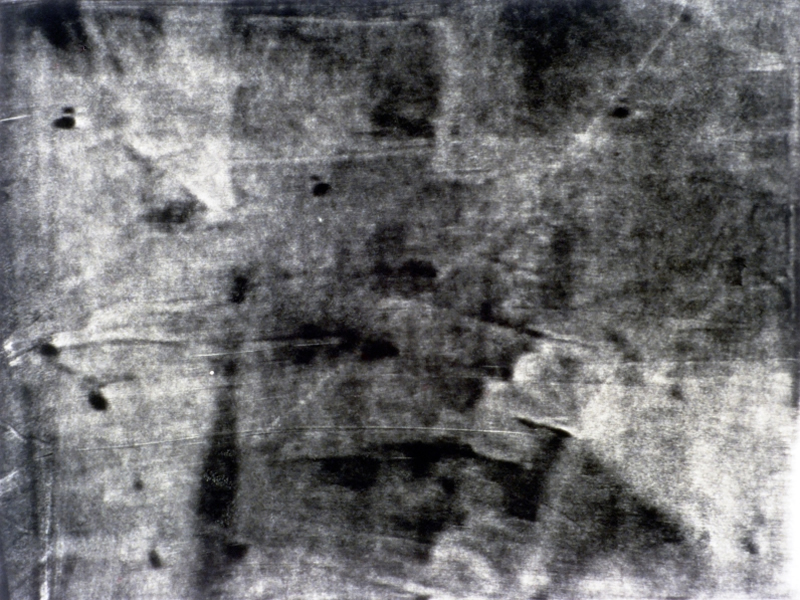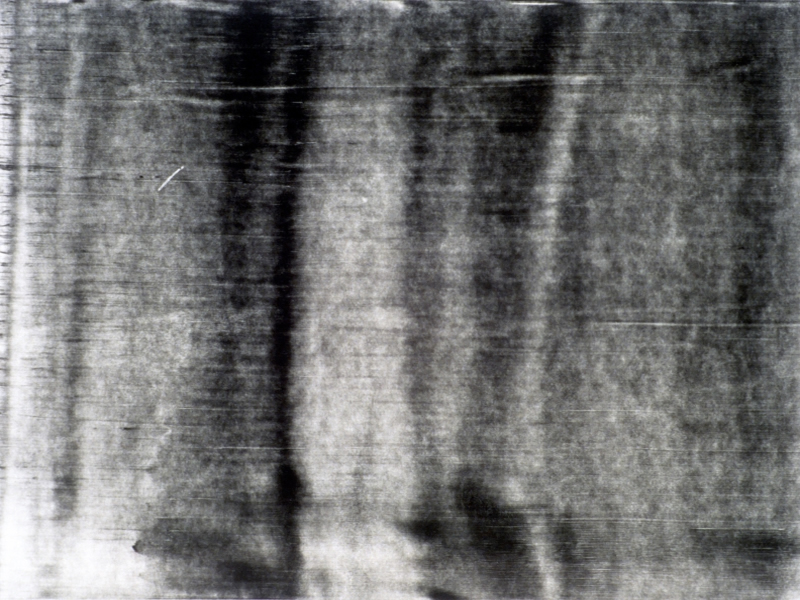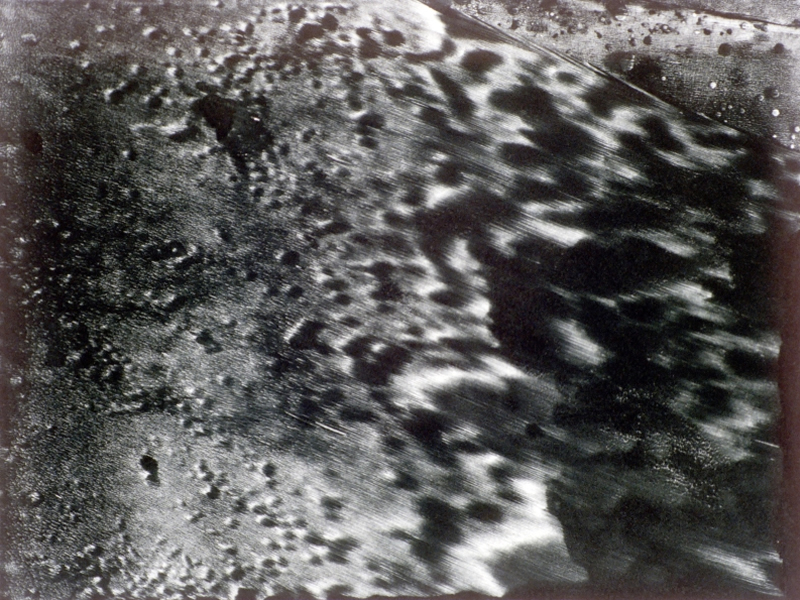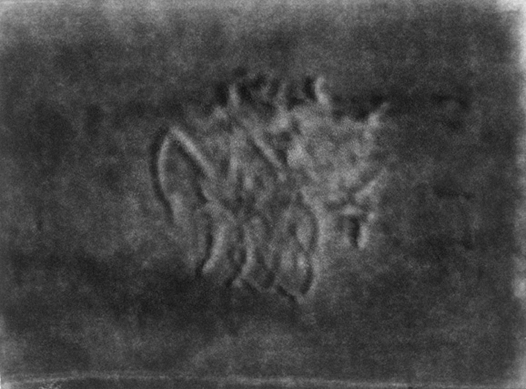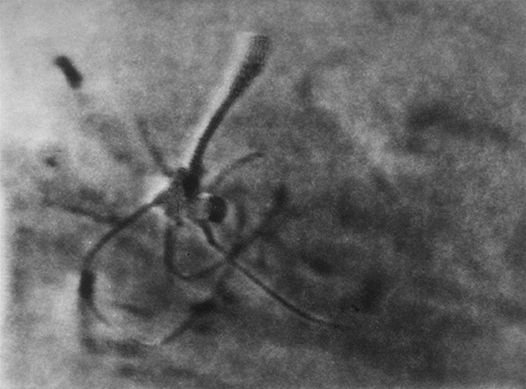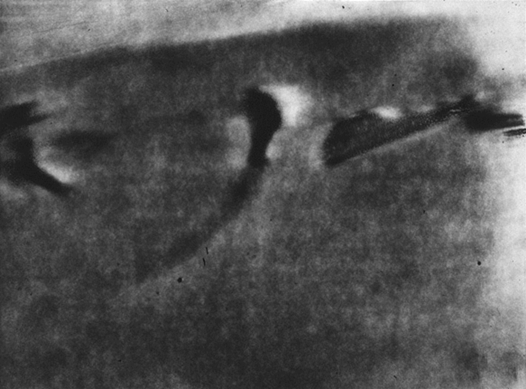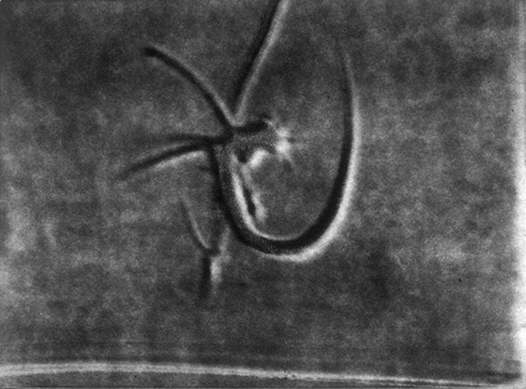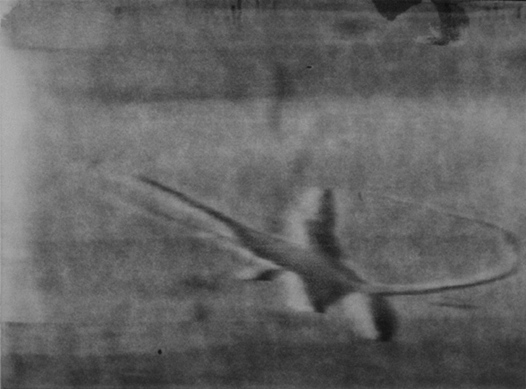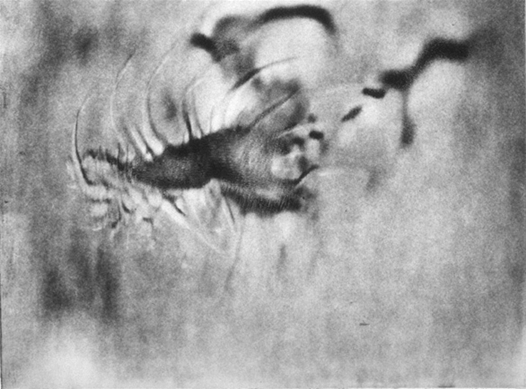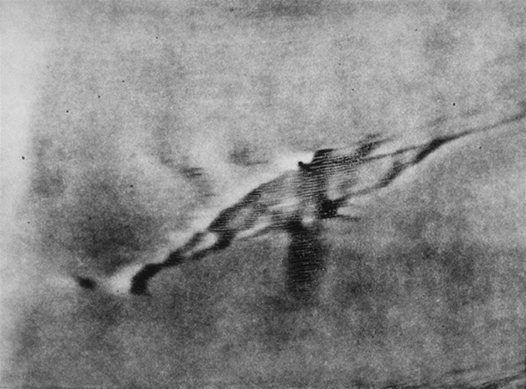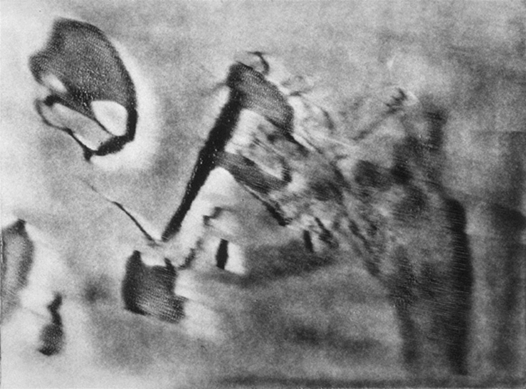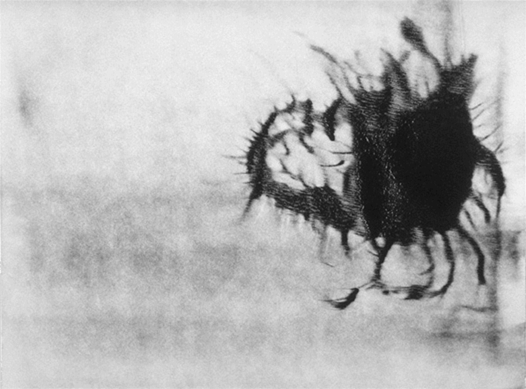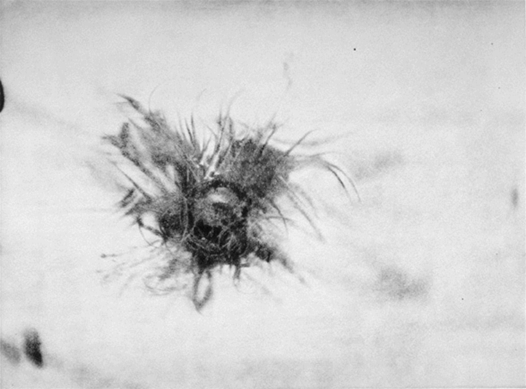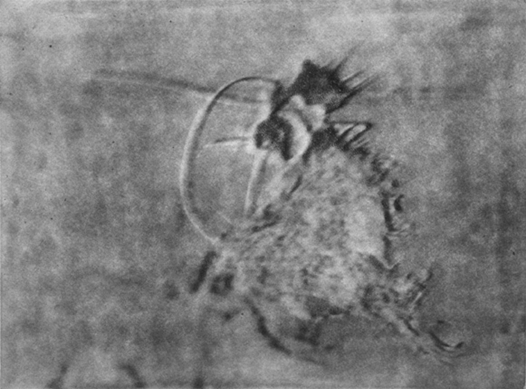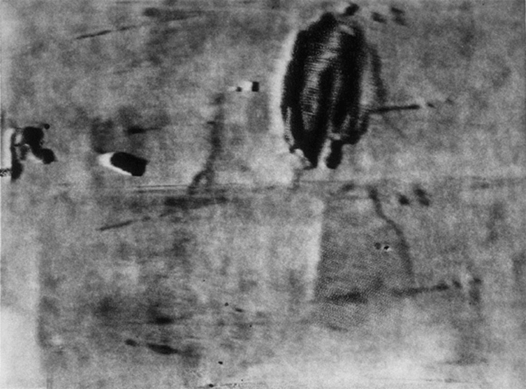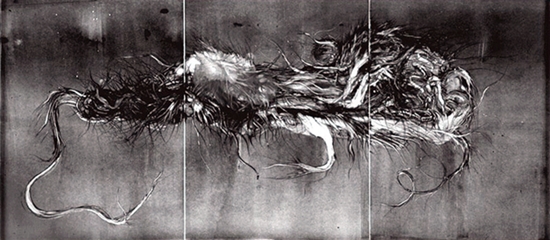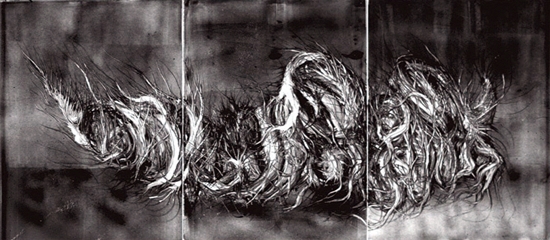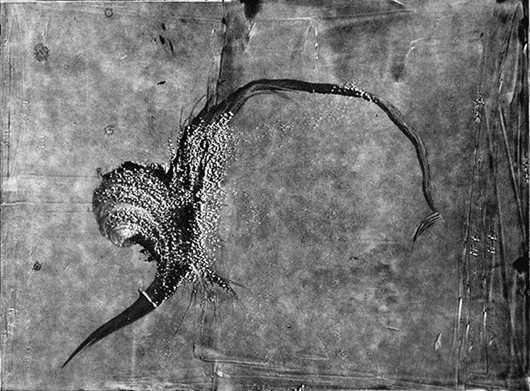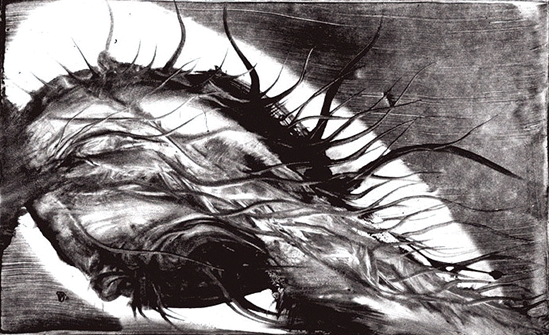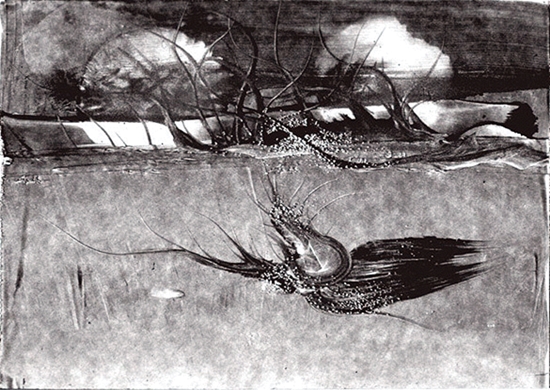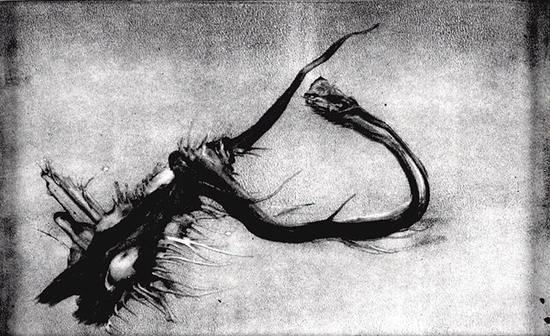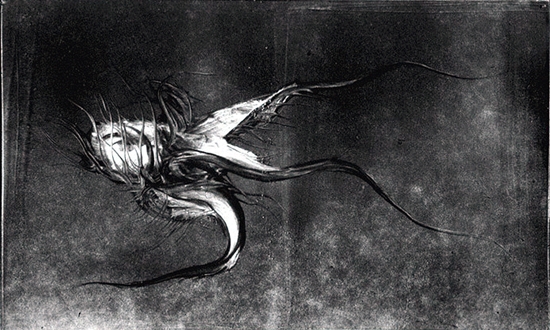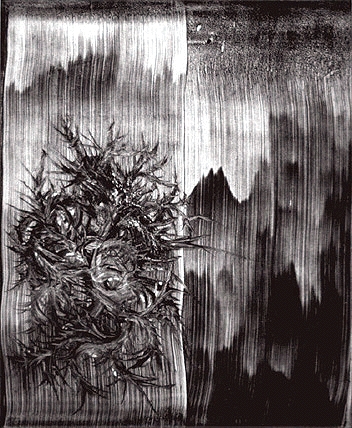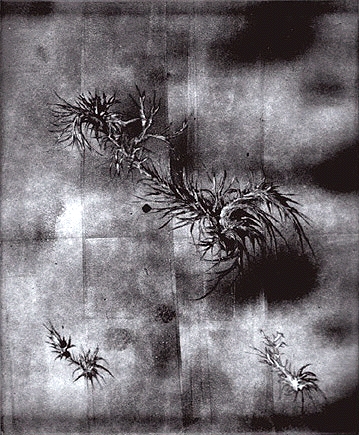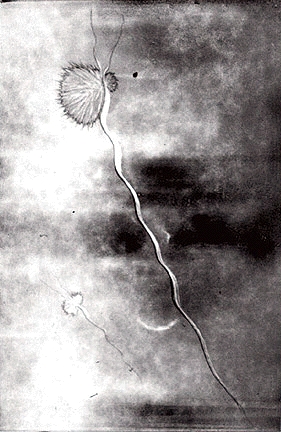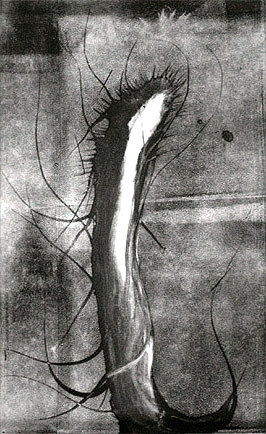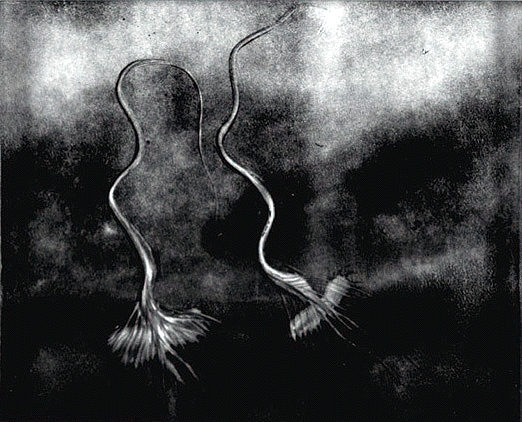The value of Saginian’s monotypes hinges on both their rigorous commitment to the specificity of the medium and the gaps or disparities between what we imagine, what we see, and what we know. The images strongly evoke black and white photography, and more specifically the daguerreotype, an early photographic process in which an image was produced on a light-sensitive silver-coated copper plate and developed in mercury vapor. We look at the prints and might imagine aerial landscapes, celestial pictures, microscopic objects, perhaps birds or fish, or smoky skies from falling airplanes in WWII newsreels.
There is no eccentric or exotic technique involved: these are monotype prints made with black or sepia ink applied on zinc plates and put through the press. As a process artist, Saginian makes his unplanned abstractions in printing sessions, then edits the results by intuitive but not unconscious criteria: he aims to find correspondences between the prints and memory traces in his own mind.
One of the reasons Saginian was drawn to this abstract "accidental" printmaking process was that he wished to do away with all the discourses of personal expression and the artist's hand that came with painting. When I asked him how he discovered this somewhat archaic medium, he said that using the press helped him to "disconnect" from the work. He wishes his own work to have an influence or to make an impression on him, the way it does on other viewers. The medium here quite literally mediates, not between the artist's feelings and the viewer's perception, but between two other media: Printmaking and Photography. The monoprints are abstract, made with ink on paper, but there is always also the photographic look: even though we know very well that there is no photography involved, they tantalize us with the promise of indexicality—the notion that there just may be a causal relationship between image and reality.
Paradoxically but understandably, as in the case of many other artists who consciously employ
a mechanical working process, Saginian’s work appears intensely personal and determinate,
even as he steps back from it and treats the process as a kind of chance operation. The dream
of "pure abstraction" collides again and again with memory, narrative, and psychology.
—Annetta Kapon
THE elasticity of drawing is always a central issue at the Drawing Center in SoHo, but it takes center stage in its ''Selections Spring '97'' exhibition. This impressive show introduces three talented young artists, each of whom stretches drawing to create different kinds of hybrids, whether physical, intellectual or cultural.
The standout is Shahzia Sikander, an artist from Pakistan now living in Houston and one of the Whitney Biennial's new discoveries. Ms. Sikander is thoroughly trained in the refined art of the Indian miniature, but also seems capable of drawing any way she wants. With a 90's sense of feminist verve and breathtaking skill, she conducts a series of surgical strikes, extracting figures from traditional miniatures in some drawings while seamlessly insinuating photographs of herself into exquisite facsimiles in others.
Sometimes she executes notational mixtures of styles; elsewhere she creates monumental wall paintings, most notably one of a multiarmed, weapon-bearing goddess. Mutating forms, bodies and identities, along with an unraveling animated white chador, are recurring themes; a restrained ferocity, laced with humor, delicacy and pride is the usual tone. Although slickness is an incipient danger, Ms. Sikander's multi-perspective art brims with promise.
Almost as striking is the work of Pauline Stella Sanchez, an artist from Los Angeles who fuses drawing with the scientific and the decorative in three radiating floor installations. These are made of dozens of small studies, some computer generated, others rendered meticulously by hand.
Growth and mutation are a theme here, too, but the action is more abstract, conducted by a series of bright blue sporelike aggregates that migrate effortlessly from the cellular to the geometric to the fanciful, and occasionally into three dimensions, where they tend to be bright yellow. It is some indication of the breadth of Ms. Sanchez's free-wheeling motifs that they can bring to mind the efforts of both the Brazilian painter Beatrice Milhazes and the American Conceptualist Mel Bochner.
In this company, the relatively modest work of Oshin Saginian holds its own through sheer mysteriousness. Mr. Saginian, who also lives in Los Angeles, turns drawing into a bridge between painting and early photography in a series of relatively modest monotypes.
These soft, muted images suggest microscopic worlds and also vast expanses of desert sands seen from above, or sightings of unknown celestial bodies captured by a deficient telescope. While the work of the other artists here exude a sense of labor-intensive skill, whether human or technological, Mr. Saginian's sepia surfaces indicate little about their actual process of formation. They're too delicate not to evoke a sense of touch, but that touch could be nature's.
Across the street from its main space, the Drawing Center has opened its own projects space, called the Drawing Room, on the ground floor of 40 Wooster Street (until recently the Michael Klein Gallery). The inaugural show introduces the work of Tacita Dean, a young English artist who pushes drawing toward film.
Working in chalk on several large blackboards, Ms. Dean creates the storyboard of a possible film, "Disappearance at Sea V." Cryptic notes indicate plot and camera angles, while spare, large-scale outlines magically convert the blackboard into a heaving sea that, frame by frame, consumes a struggling two-masted boat, leaving a group of men pulling at the oars of a small skiff at story's end.
Ms. Dean's drawing style is conventional, almost illustrational, but she gets the most out of smudged white chalk; the narrow gallery space, which surrounds the viewer with black ocean, also works in her favor. One is pulled back and forth between the artificiality of Ms. Dean's stage directions and the mounting drama of the story, all the while being made aware, as in the show across the street, of drawing's uncanny resiliency. Pushed in new directions, it still retains its inherent immediacy and magic.
"Selections Spring '97" is at the Drawing Center, 35 Wooster Street, near Grand Street, SoHo, through March 29. Tacita Dean's work remains at the Drawing Room, 40 Wooster Street, through May 3.
—Roberta Smith
